Naples, a city where history is intertwined with modernity, culture is mixed with unique traditions, and every corner tells a fascinating story. To visit it is to immerse oneself in a world of timeless beautywhere art, gastronomy and scenery come together in an unforgettable experience. Here is a guide to discover the most emblematic places and hidden gems of Naples.
Spaccanapoli, the iconic strip that runs through the beating heart of Naples, serves as a wonderful prelude to all that the city has to offer. This legendary street, whose name conjures up the image of a city 'split' in two, is much more than just a corso: it is a journey through centuries of Neapolitan history, culture and vibrant, uninterrupted traditions. Strolling along Spaccanapolione is immersed in an atmosphere that seems to defy time, where every stone, every corner, tells stories of bygone eras.
The historic centre of Naplesof which Spaccanapoli is an integral part, is a fascinating maze of narrow alleys, secular churches, historic buildings, e workshops that keep traditions alive. This area, recognised as a UNESCO World Heritage Site, is a treasure trove of art and culture that reflects the authentic soul of Naples. Among these alleys, the echoes of the voices of street vendors mingle with the scents of traditional dishes, offering a unique sensory experience.
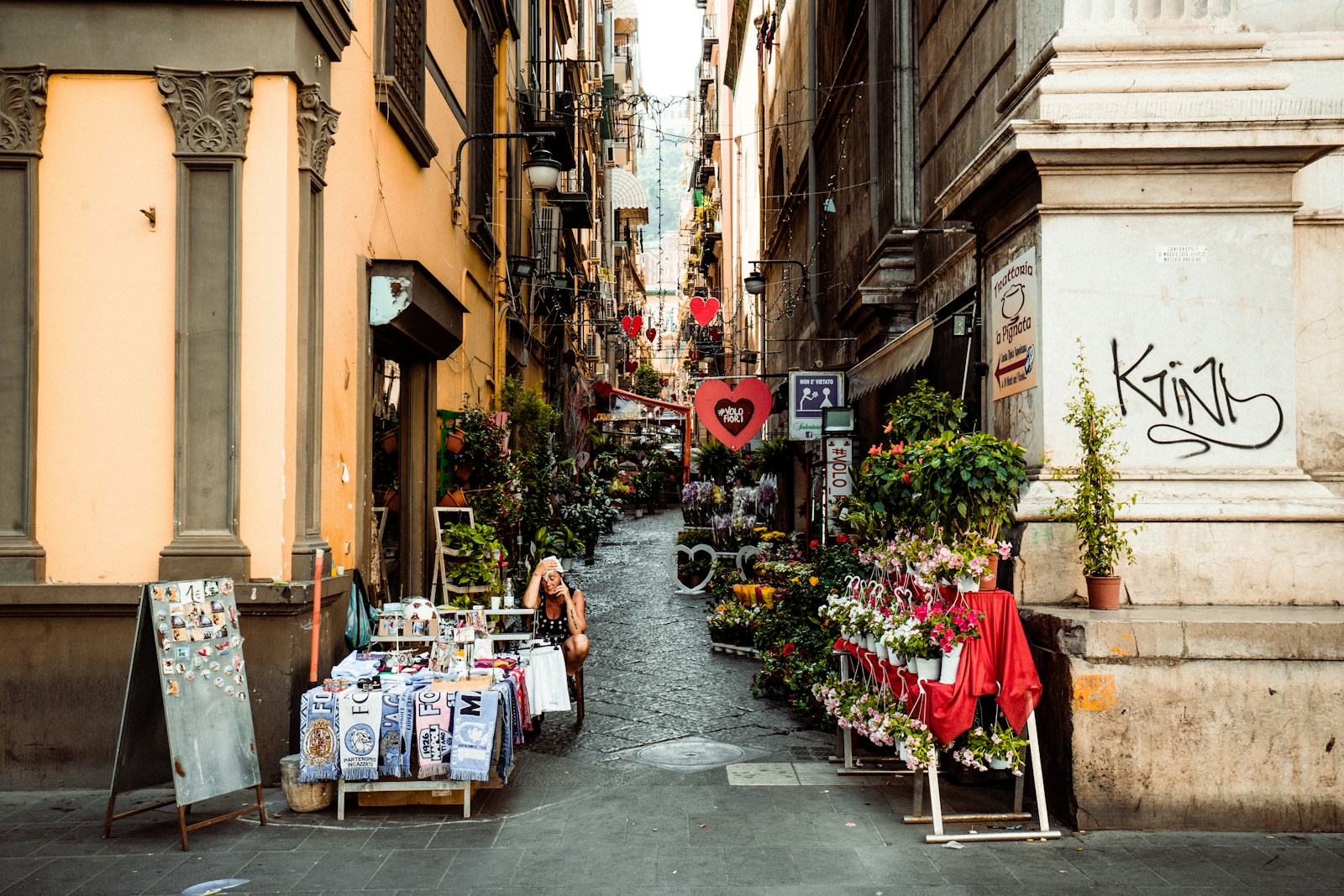
Historic Centre of Naples
One of the hidden gems of this historical maze is undoubtedly the Sansevero Chapelalso known as the Chapel of Santa Maria della Pietà. This Baroque monument hides within it one of the most amazing masterpieces of sculptural art: the Veiled Christ. The sculpture, the work of Giuseppe Sanmartino, is famous for its incredible depiction of the body of Christ under a transparent veil, made of marble with such mastery that it almost looks like real fabric. The artistry and mystery surrounding the creation of this work attract visitors from all over the world, eager to contemplate the perfection of this masterpiece up close.
The historic heart of Naples is a place where the past meets the present, and history is experienced at every step. Exploring it means embarking on an unforgettable journey through the centuries, in a place where art, culture and daily life intertwine in a lively and colourful mosaic. The streets of Spaccanapoli and the historic centre are the stage on which the never-ending spectacle of Neapolitan life unfolds, an authentic representation of the traditions and hospitality that characterise this unique city.
Immerse yourself in this maze of history and beauty is a soul-enriching experience, offering food for thought on the cultural richness of Naples and the importance of preserving its priceless heritage. A visit to Spaccanapoli and the historic centre thus becomes not only a moment of tourist discovery, but a true path of personal enrichment, where every step reveals new wonders and every alley hides stories ready to be told.
Pompeii and Herculaneum represent two of the most extraordinary testimonies to life in ancient Romepreserved for millennia under the volcanic ash of the eruption of the Vesuvius in 79 AD. These archaeological sites, located a short distance from Naples, offer visitors the unique opportunity to literally take a plunge into history, walking among the ruins of cities that were once alive and pulsating.
Pompeii is, without doubt, one of the most famous and most visited archaeological sites in the world. Covering some 66 hectares, this ancient Roman city offers an incredibly detailed insight into daily life over two thousand years ago. The cobbled streets, houses, temples, theatres and frescoes make it possible to imagine the days of its ancient inhabitants, their affairs, prayers and amusements. The Forumthe Lupanare, the House of the Vettiiand theAmphitheatre are just some of the wonders this site has to offer. The almost perfect preservation of some of the bodies, victims of the eruption, adds a deeply emotional note to the visit, making tangible the tragedy that struck this prosperous Roman city.
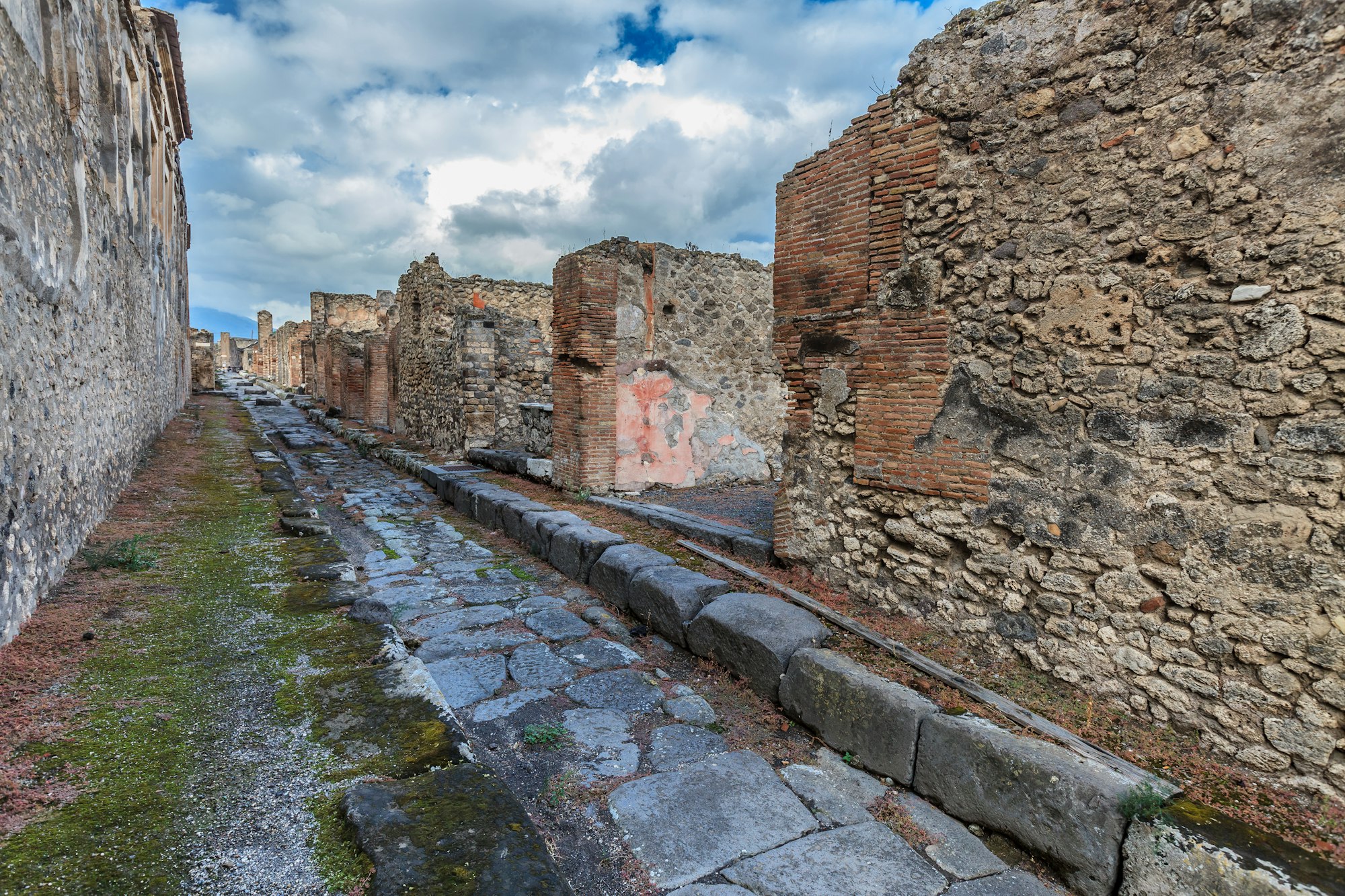
Pompeii
Although less famous than Pompeii, Herculaneum offers an equally fascinating perspective on the past. This site, smaller and more manageable in a visit, preserves some wooden structures and other organic materials better than Pompeii, offering a more complete view of the dwellings and lives of its inhabitants. The ancient villassuch as the splendid Villa of the Papyri, and the frescoes which adorn many of the houses, reveal the taste for art and beauty that characterised daily life in these Roman cities. Herculaneum's location, closer to the sea than Pompeii, and its smaller number of visitors, allow the site to be explored at a more leisurely pace, fully savouring the charm of this incredible plunge into history.
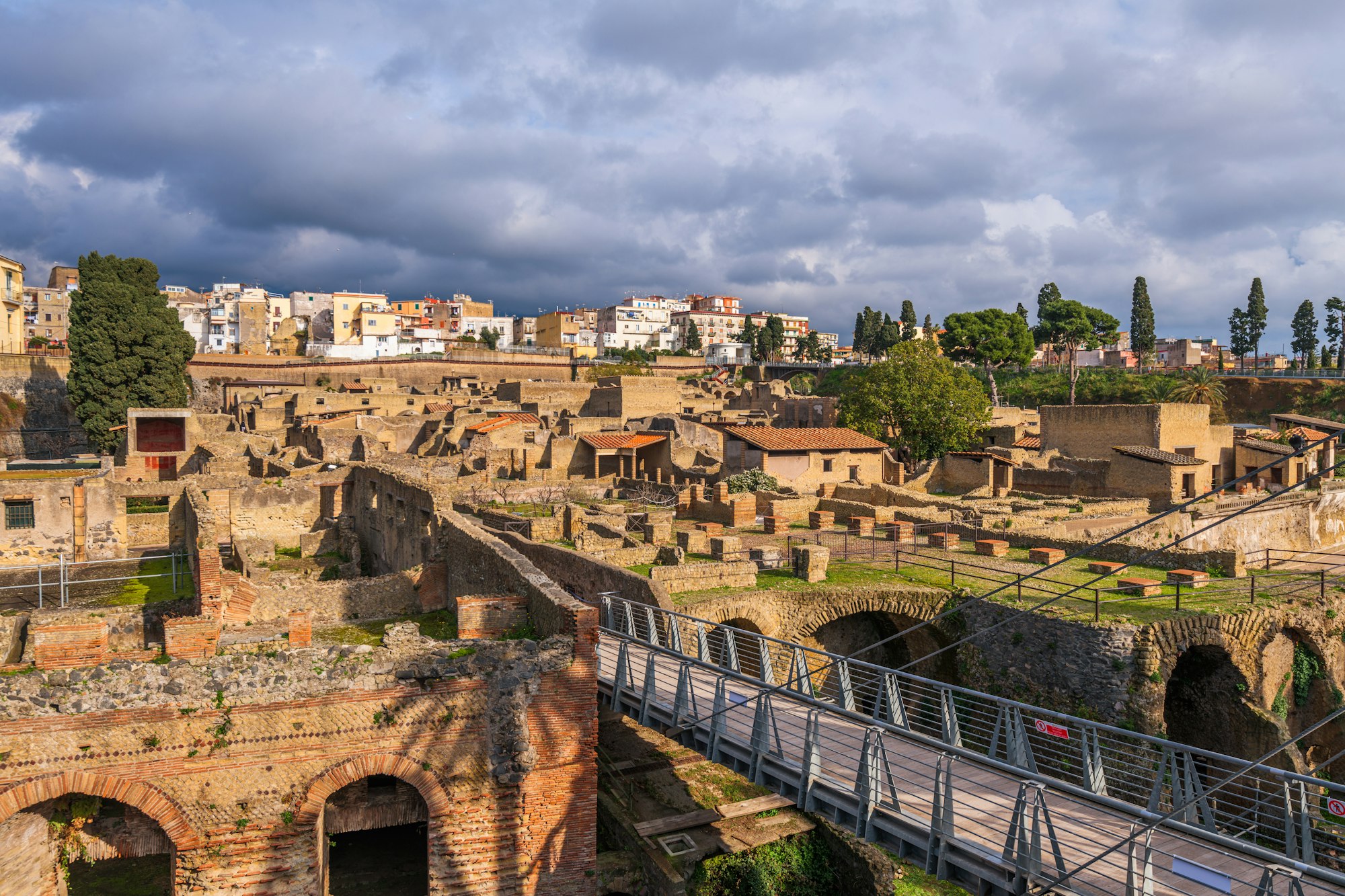
Ancient Roman Ruins of the City of Herculaneum
Visiting Pompeii and Herculaneum is not just a tourist activity, but a deeply educational and emotional experience. It is about walking on roads that saw chariots and pedestrians pass more than two thousand years ago, about entering the homes where Roman families lived, worked and entertained themselves, about touching the greatness and at the same time the fragility of human civilisation. The historical, cultural and emotional importance of these sites makes them unmissable destinations for anyone visiting Naples and its surroundings, offering invaluable lessons on our shared past and stimulating reflections on our existence and future.
Pompeii and Herculaneum remind us how precious and fragile our cultural heritage is and how important it is to preserve it for future generations. Their existence is a reminder not to forget the lessons of the past, but also an invitation to marvel at man's ability to build, create art and live meaningful lives under the imposing shadow of the nature.
The Vesuvius rises majestically in the panorama of Naples, an indissoluble symbol of the city and its thousand-year history. This volcano, one of the few still active in Europe, represents not only a natural monument of incomparable beauty but also a living testimony to the force of nature that has shaped and continues to influence life in the Neapolitan area. Its presence is a constant reminder of the shared destiny between the city and the volcano, a relationship forged over the centuries between admiration, study and caution.
Climbing the Vesuvius is a breathtaking experience, not only for the physical effort but for the emotions it arouses. The route to the crater is a journey through different landscapes: from fertile slopes planted with vineyards and olive groves, witnesses to the rich agricultural offerings that the volcanic soil guarantees, to rougher and rockier terrain, where nature seems to take over from human handiwork. The views from these paths are spectacularNaples and its bay unfold in a panorama that also embraces the islands of Capri, Ischia and Procida, offering one of the best vantage points of the Campania landscape.
Arriving at the crater of Vesuvius means reaching the summit of this adventurewhere the lunar landscape of the crater opens up before visitors, revealing the power of the volcano. Looking inside the crater is a unique experience, allowing one to contemplate the power of the earth up close and to reflect on the smallness of human beings in the face of nature's majesty. The breathtaking view enjoyed from this high point is a priceless reward, making the journey an unforgettable moment in the life of anyone who makes it.
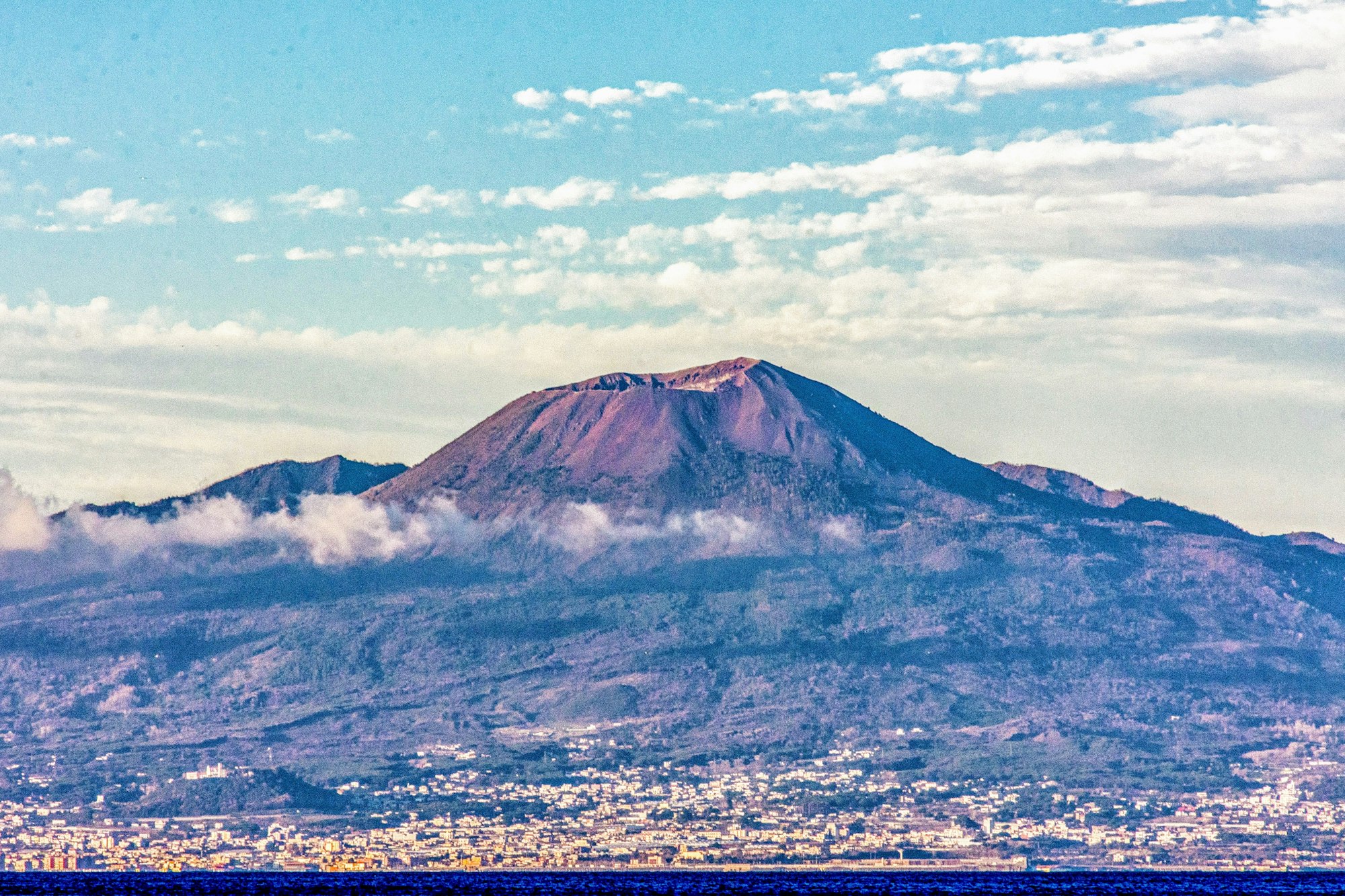
View of the volcano Vesuvius in Pompeii, Naples, Italy
In addition to its natural beauty and grandeur, Vesuvius is a guardian of history. Its eruption in 79 A.D., which buried Pompeii and Herculaneum, is one of the best known and most studied volcanic events in history, a moment that froze two Roman cities in time, giving us today an incredibly detailed picture of ancient life. The volcano, therefore, is not only a natural phenomenon but also a site of great archaeological and cultural importance, which continues to stimulate the curiosity and the interest of scholars, tourists and history enthusiasts from all over the world.
Vesuvius is now also a national parkestablished to protect this unique environment and to promote sustainable development of the area. The park's initiatives include biodiversity protection, scientific research and environmental education, demonstrating how it is possible to live with an active volcano while preserving the richness of the landscape and the safety of local communities.
In conclusion, Vesuvius is more than just a volcano; it is a symbol of Naples and Campania, a natural monument that embodies the history, culture and vitality of this land. Its exploration is an enriching adventure not only physically, through the hiking route, but also spiritually, offering lessons on the power of nature, the history of humanity and the beauty of our planet.
The Royal Palace of Casertalocated a short distance from the bustling city of Naples, is an architectural and historical jewel that enchants every visitor with its magnificence and beauty. Conceived by architect Luigi Vanvitelli and commissioned by Charles of Bourbon, these structures stand as a testament to the ambition and grandeur of the bourbon courtrepresenting one of the most significant examples of baroque architecture in Italy. Declared UNESCO World Heritage Site, the Reggia di Caserta is not just a tourist attraction, but a real journey through the history, art and culture of the Baroque era.
The Royal Palace of Caserta, with its four inner courtyards, imposing façade and huge Italian-style park, demonstrates the genius of Luigi Vanvitelli, who was able to create a masterpiece that is still considered one of the grandest royal buildings in Europe. The structure covers an area of more than 45,000 square metres and has more than 1,200 rooms, including the court theatre, the library and the Grand Gallerya 120-metre long corridor adorned with breathtaking frescoes and stuccoes.
Equally impressive are the Italian gardens of the Reggia, extending over more than 120 hectares. These gardens are a perfect example of harmony between architecture and nature, where sculptural fountains, waterfalls, and pools of water blend with the lush greenery in an organic and evocative whole. Among the attractions most popular are the Fountain of Diana and Actaeonthe Great Waterfall and the English GardenThe latter was designed by the English architect John Graefer, commissioned by Queen Maria Carolina of Austria, who introduced a different landscape style, more natural and 'wild', compared to the formality of the Italian garden.

Royal Palace of Caserta
To visit the Royal Palace of Caserta is to take a journey back in time, to discover the daily life, customs and passions of the Bourbon court. Every room, every garden, tells stories of pomp and ceremony, of political intrigues and the daily life of the royal family and the court. The Reggia is also a place of culturehosting temporary exhibitions, events and concerts that continue to bring this extraordinary place to life, linking the past with the present.
The cultural, historical and artistic importance of the Royal Palace of Caserta makes it an essential destination for anyone visiting Campania. In addition to being a monument of inestimable value, the Royal Palace is a place where the beauty of art and architecture is combined with the perfection of nature, offering a unique and unforgettable experience. A visit to the Reggia di Caserta is not only an opportunity to admire a masterpiece of Baroque artbut also to immerse oneself in an atmosphere of times gone by, letting oneself be enchanted by the majesty and grandeur of one of the most beautiful and significant palaces in Italy.
La Neapolitan cuisine represents the very essence of Naples' cultural identity, a sensory journey through flavours, aromas and traditions that have been intertwined for centuries. Known throughout the world mainly for the Neapolitan pizzarecognised as an intangible heritage of humanity by UNESCO, the gastronomy of Naples offers a culinary repertoire that goes far beyond this famous dish, providing unique gastronomic experiences that tell the story, culture and soul of this wonderful city.
La Neapolitan pizza is more than just a dish: it is a symbol of conviviality and Italian culture around the world. Its simplicity, with genuine ingredients such as San Marzano tomatoes, buffalo mozzarella di bufala Campana DOP, fresh basil, extra virgin olive oil and, of course, leavened dough baked in a wood-fired oven, conceals a wealth of flavours and mastery in its preparation that has been handed down from generation to generation. To visit Naples and not enjoy a pizza in the heart of the city, perhaps in one of its historic pizzerias, is like never having really visited.

Pizza Margherita in Naples
The Neapolitan confectionery tradition boasts iconic desserts such as the baba and the sfogliatellawhich encapsulate the essence of Neapolitan pastry. The baba, with its characteristic shape and soft, rum-soaked dough, and the sfogliatella, crispy outside and soft inside, with its filling of ricotta, semolina, and candied fruit, are authentic expressions of Neapolitan creativity and passion for sweets. Each taste is a journey through time, an open door to the habits and tastes of a people who have made cooking an art.

Neapolitan rum baba
The Neapolitan coffee is not just a drink, but a real social ritual, a moment of sharing and a break from the daily hustle and bustle. Coffee in Naples is enjoyed strong, full-bodied and sweetened, often accompanied by a small glass of water to enhance the flavour. Neapolitan espresso, served in the characteristic 'cuccumella', is the prelude or finale to every meal, a small but intense pleasure that brings together friends and families in every corner of the city.

Neapolitan Coffee
Exploring Neapolitan gastronomy means embarking on an endless journey through the flavours, colours and stories of a unique city. Each dish, each ingredient, tells a part of the history of Naples, its fertile lands, its generous sea and its popular traditions. Savouring Neapolitan cuisine is like reading an open book about the lives of the people of this city: a mix of simplicity, ingenuity and passion that makes each dish a work of art.
The gastronomy of Naples is, therefore, much more than a simple culinary experience; it is an emotional and cultural journey that touches the heart and soul, leaving indelible memories in those fortunate enough to savour its delights. The soul of Naples reveals itself not only in its streets, monuments and works of art, but also and above all in the unique and irresistible flavours of its cuisine, which bears witness to a millennial history and a rich and welcoming culture.
Naples is not only a city of extraordinary natural and historical beauty, but also a melting pot of art and culture that extends far beyond its famous archaeological sites. At the heart of this cultural heritage lies the Naples National Archaeological Museumone of the world's most prestigious institutions dedicated to the art and archaeology of ancient Rome. But Naples also knows how to look to the future through its many contemporary art galleriesincluding the MADRE, which offer an innovative and creative perspective on the city.
The National Archaeological Museum houses an unrivalled collection of artefacts that tell the story of ancient Rome, with a special focus on treasures recovered from the sites of Pompeii and Herculaneum. Prominent among these are the mosaics, the sculptures and the frescoes that once decorated the houses and public places of these cities buried by the eruption of Vesuvius. The famous Farnese Collectionpart of the legacy of one of the most influential families of the Italian Renaissance, adds further prestige to the museum with its classical sculptures of exceptional beauty and historical importance.
Exploring the Archaeological Museum means taking a plunge into the daily life, beliefs and artistic expressions of a people who have left an indelible mark on the history of mankind. Each hall, each find has a story to tell, offering visitors the chance to connect with the past in a direct and exciting way.
If the National Archaeological Museum represents the glory of the past, the contemporary art galleries of Naples are open windows on the present and future of the city. Among them, the MADRE (Donnaregina Museum of Contemporary Art) stands out for its commitment to promoting Italian and international contemporary art. Through temporary exhibitions and permanent collections, the MADRE explores current themes and offers new perspectives on the world around us, reflecting the vitality and creativity that animate Naples today.
To visit it is to immerse oneself in a dialogue between generations, where the works of contemporary artists respond to questions posed by ancient art, and vice versa. Exhibitions at MADRE are often accompanied by workshops, lectures and meetings with the artists, making the museum a living place for cultural exchange and personal growth.
The coexistence of the National Archaeological Museum and the contemporary art galleries in Naples represents a bridge between past, present and future, demonstrating how the city is deeply rooted in its history while confidently projecting itself into new artistic expressions. This duality enriches the experience of those who visit Naples, offering not only a journey through the centuries but also an immersion in the artistic trends that will shape our tomorrow.
Walking through the halls of the Archaeological Museum and strolling among the works on display at the MADRE allows one to understand the continuity of artistic research and man's perennial ability to express himself through art. Naples, with its extraordinary cultural heritage and its incessant desire for innovationthus confirms itself not only as a custodian of the past but also as a laboratory of ideas and creativity, able to inspire and amaze visitors from all over the world.
The Naples waterfront is one of the most evocative and charming promenades Italy has to offer, a place where time seems to slow down to allow anyone walking along it to savour the beauty in every detail. Stretching along the coast, with a view that embraces the Castel dell'Ovo and extends to the majestic Vesuvius, the waterfront is the beating heart of Neapolitan life, a crossroads of stories, cultures and breathtaking landscapes.
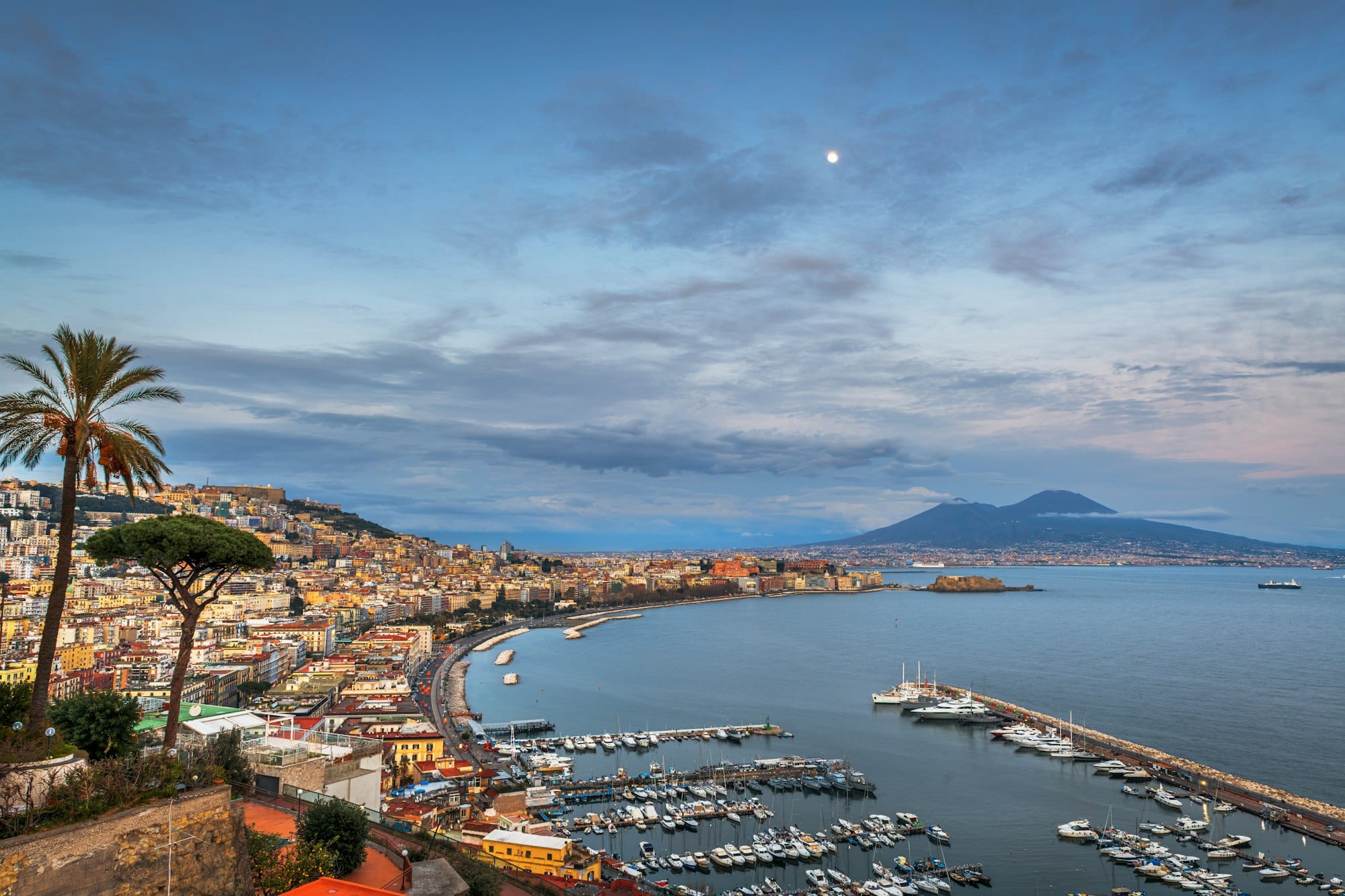
View of the Naples waterfront area
A walk along the Naples waterfront is an experience that involves all the senses: the sight of the sea stretching to the horizon, the salty scent of the air, the sound of the waves gently lapping against the shore and the warmth of the sun reflecting on the water create an atmosphere of serenity and peace. The view of Vesuviuswhich dominates the panorama with its grandeur, adds a touch of majesty to the landscape, recalling the power of nature and the thousand-year history of this land.
The Castel dell'Ovo, the oldest castle in the city, stands on an island connected to the mainland by a small bridge. Its unique position, guarding the Gulf of Naples, makes it not only a historical and cultural landmark but also one of the places most photographed and admired by visitors. According to legend, the castle's name derives from an egg that the poet Virgil supposedly hid in its foundations to ensure its stability. Today, the castle is a venue for exhibitions and cultural events, continuing to live on in the heart of the city.
But what really characterises the waterfront and makes it a unique place in the world is the people of Naples. The friendliness, hospitality and passion for life of the Neapolitans is contagious; a simple stroll can turn into an opportunity to meet and share. The cafés, restaurants and stalls along the way offer the opportunity to sample local delicacies, while street performers and musicians fill the air with melodies, making every moment spent on the promenade an unforgettable memory.
There is nothing more romantic and evocative than admiring the sunset on the Naples seafront. The colours of the sky merging with those of the sea create a natural spectacle of incomparable beauty, a perfect moment to reflect on the day gone by or simply to enjoy the peace of the moment. The breathtaking view that can be admired from this corner of paradise makes it clear why Naples is considered one of the most beautiful cities in the world.
The Naples waterfront, with its natural, historical and cultural beauty, is a place where every step tells a story, every view opens up a world and every encounter leaves a mark. It is an experience to be lived with an open heartan invitation to discover the authentic essence of Naples, amidst the majesty of its sea and the welcoming warmth of its people.
Naples is a city to be experienced with all the senses: from its breathtaking views to its rich history, from its vibrant culture to its delicious cuisine. Every corner of Naples has something to offer, making it an unmissable destination for anyone wanting to discover the authentic Italian beauty. Exploring Naples means embarking on an unforgettable journey in the heart of Mediterranean culture, where every step reveals new wonders.
We are a young Web Agency with more than 10 years of experience, we love travelling and discovering new places, that is why we write every day on Italia Delight our travel site.

Italia Delight is your definitive guide to Italian restaurants, offering a comprehensive directory and web marketing services to enhance every dining experience. Discover, taste and connect with Italian tradition.
2024 G Tech Group S.R.L.S. - Via di Gagia 22,38086 Giustino (TN) - P.IVA 02743570224
Project in collaboration with Gianluca Gentile e Glocal Consulting
To provide the best experiences, we and our partners use technologies like cookies to store and/or access device information. Consenting to these technologies will allow us and our partners to process personal data such as browsing behavior or unique IDs on this site and show (non-) personalized ads. Not consenting or withdrawing consent, may adversely affect certain features and functions.
Click below to consent to the above or make granular choices. Your choices will be applied to this site only. You can change your settings at any time, including withdrawing your consent, by using the toggles on the Cookie Policy, or by clicking on the manage consent button at the bottom of the screen.